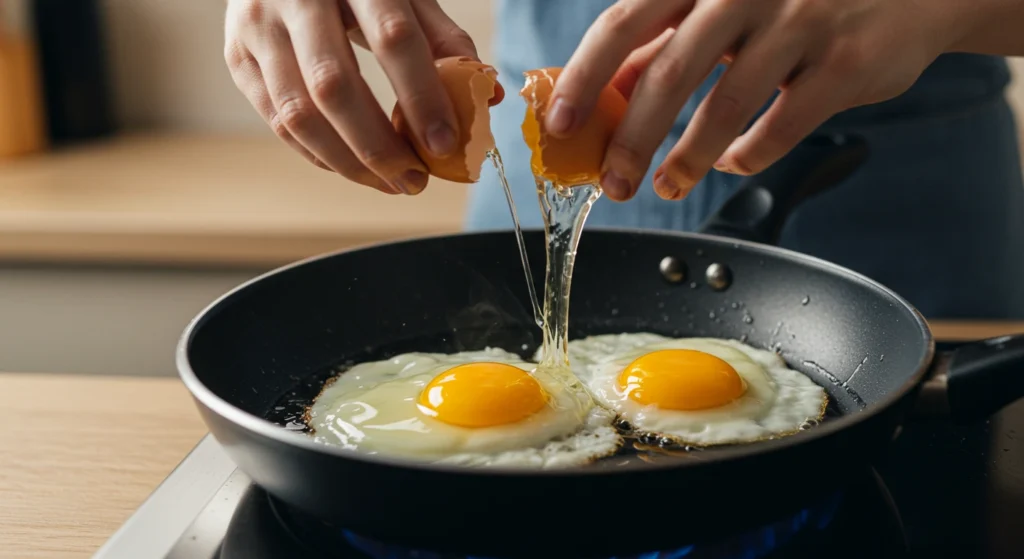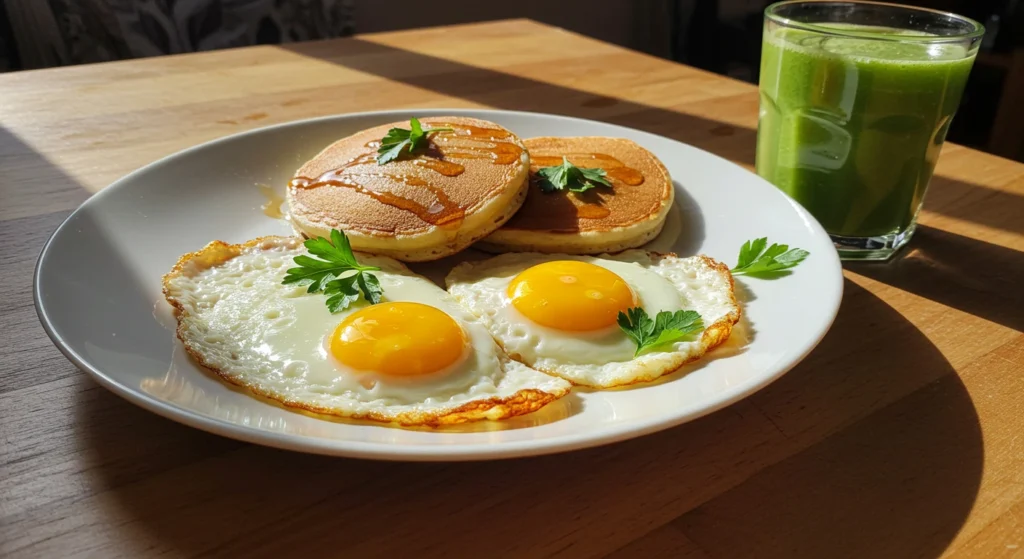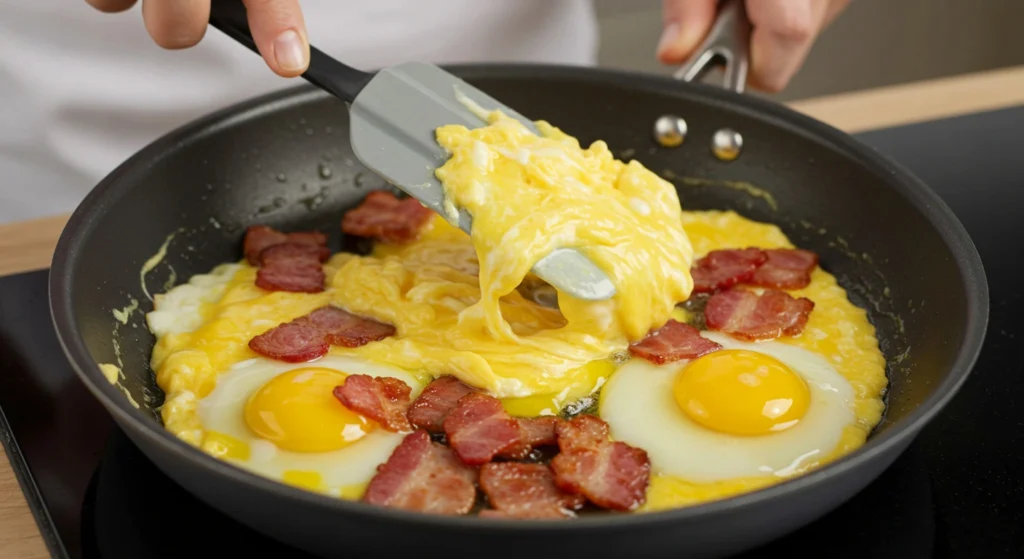Alright, let’s crack into it! 🍳 Fried eggs are like the rockstars of the breakfast world. Who doesn’t get excited when a plate of golden yolks and silky whites arrives? Whether you’re a seasoned chef or just starting your cooking journey, you’ve probably had your fair share of fried eggs. But did you know that there are actually four main types of fried eggs? Each type has its own unique flavor, texture, and way of cooking. So, let’s embark on this delicious journey and discover how to make the most out of each fried egg style!
Table of Contents
The Four Types of Fried Eggs Explained

Now, let’s explore the four main types of fried eggs: Sunny-Side Up, Over-Easy, Over-Medium, and Over-Hard. Each has its own special charm and cooking method, so let’s break it down!
1. Sunny-Side Up Eggs
Sunny-side up eggs are like the cheerful best friends of the breakfast table—their bright yellow yolks radiate positivity! These eggs are cooked on one side only, leaving the yolk soft, runny, and swimming in its delicious goodness. The edges are lightly cooked but still tender, giving you that perfect, mild flavor with just a hint of crispness.
Characteristics of Sunny-Side Up Eggs
Sunny-side up eggs are known for their vibrant appearance. The glossy surface is simply enticing. If you’ve ever watched someone flip an egg over casually only to discover they have a sunny-side up creation, you’ll understand how versatile and charming they can be!
How to Cook Sunny-Side Up Eggs Perfectly
Cooking these beauties is a piece of cake! Here’s how:
- Heat a non-stick frying pan over low to medium heat and add a little butter or oil.
- Crack the egg gently into the pan. You want to keep that yolk intact!
- Cook for about 2-3 minutes until the whites are set but the yolk is still runny. If the edges start to brown, that’s okay, but watch the heat to avoid overcooking.
- Season with a sprinkle of salt and pepper. 🧂
“When life gives you lemons, make scrambled eggs… but when life gives you eggs, make them sunny-side up!” 😄
2. Over-Easy Eggs
Next up, we have over-easy eggs, which are like the cool cousins of sunny-side up eggs—they flipped to the other side for just a quick moment. The best part? You still get that nice runny yolk that flows out like liquid gold when you break into it.
Understanding Over-Easy Eggs
What do you think about this? Over-easy eggs showcase a delicate balance. The whites are fully cooked, while the yolk remains gloriously runny. This style is a fantastic comfort food option!
Tips for Cooking Over-Easy Eggs
Here’s how to master over-easy:
- Start by preparing your frying pan like you did for sunny-side up eggs. Low to medium heat works wonders.
- Crack the egg and let it cook until the whites start to set, around 2 minutes.
- Using a spatula, carefully flip the egg over and let it cook for about 30 seconds. You want the yolk to remain runny, so don’t let it sit too long!
- Season and serve hot!
“Over-easy eggs are like that perfect hug—you want it to be soft and warm without being overdone!” ❤️
3. Over-Medium Eggs
Over-medium eggs are the middle child of the fried egg family. They sit somewhere between over-easy and over-hard, boasting a partially runny yolk—a perfect option when you’re looking for something with a bit more substance.
What Makes Over-Medium Eggs Unique?
These eggs have the best of both worlds! The whites are fully cooked, while the yolk is partially set—offering that rich, creamy center that isn’t too runny. They’re versatile and can be paired with toast, rice, or even a fresh garden salad!
Cooking Techniques for Over-Medium Eggs
To whip up over-medium eggs, follow these steps:
- Use a similar method as the previous styles, but cook for a touch longer—about 3 minutes before flipping.
- When you flip, give it about 1 minute. You should see the yolk starting to thicken but still a bit moist.
- Serve warm, complete with your favorite seasonings!
“Over-medium eggs give you the best of both worlds—kind of like having chocolate cake and ice cream at the same time!” 🍰🍦
4. Over-Hard Eggs
Finally, we arrive at over-hard eggs—the adult of the group. These eggs are cooked longer, leaving a fully set yolk. Perfect for those who prefer their eggs without that runny surprise!
Defining Over-Hard Eggs
Over-hard eggs are no-nonsense: they’re fully cooked, and when you cut into them, you get a firm yolk. Some might think they lack excitement, but they’re perfect for sandwiches or toppings—especially if you like your eggs cooked through.
Mastering the Cooking Process for Over-Hard Eggs
To achieve this style:
- Heat the frying pan and crack the egg like before.
- Cook for about 4 minutes or until the whites are completely set, then flip for a couple more minutes. You want that yolk to be a solid pale yellow.
- Enjoy with toast or in a breakfast burrito for an extra filling option!
“Over-hard eggs are like the safety net of fried eggs—always reliable and definitely less messy!” 😄
Nutritional Value of Fried Eggs

So now that we know the four main types of fried eggs, let’s turn our attention to something equally important: their nutritional value. After all, what you eat is just as significant as how it’s cooked! 👩🍳
| Nutritional Fact | Amount per Large Egg |
|---|---|
| Calories | 72 kcal |
| Protein | 6.3 g |
| Fat | 4.8 g |
| Carbohydrates | 0.6 g |
| Cholesterol | 186 mg |
| Vitamin D | 1.1 mcg |
| Vitamin B12 | 0.6 mcg |
As you can see, eggs are not only delicious but also packed with nutrients! They provide high-quality protein, essential fats, vitamins, and minerals that are important for our bodies. Interested in incorporating eggs into your diet? Just remember to balance them out with other food groups for a well-rounded meal.
For instance, pairing that protein-rich fried egg with whole-grain toast and a side of fresh fruit can help create a breakfast that fuels your day! And let’s not forget about the versatility of eggs—they can enhance so many dishes, from salads to sandwiches!
Stay tuned as we explore common problems when frying eggs and creative variations to make your breakfast even better in the next part!
Common Problems When Frying Eggs and How to Fix Them
Introduction to Common Problems
Welcome back! Now that you’re well-versed in the different types of fried eggs, let’s tackle some of the common problems people encounter when frying eggs. 🤔 You may be surprised to learn that even seasoned cooks can struggle with fried eggs, but don’t worry! With a splash of patience and a dash of knowledge, these troubles can be easily resolved.
Frying eggs might seem straightforward, but factors like heat level, timing, and even the type of pan can impact your cooking experience. Think of it like trying to create the perfect piece of art: if you don’t have the right materials, the outcome might not meet your expectations. So, grab your spatula because it’s time to explore some egg-citing challenges and their solutions!
1. Overcooked or Undercooked Eggs
One of the most frequent complaints is overcooked or undercooked eggs. We’ve all been there, right? You crack an egg into the pan only to find it turning into a rubbery mess or still being raw in some areas. It’s like planning a fun event, only to discover there’s a major hiccup!
Why This Happens:
- Overcooking often results from using high heat or cooking for too long. On the other hand, undercooking could be due to low heat or not allowing the right cooking time.
How to Fix It:
- Start by setting your stovetop to a medium-low heat. This allows for even cooking without burning the edges or leaving the whites uncooked. 🍳
- For sunny-side up and over-easy eggs, a good rule of thumb is to keep a close eye on them. Usually, cooking for about 2-4 minutes will do the trick. Just remember to watch for that perfect moment to flip for over-easy variants!
“Patience is key when frying eggs; like watching a plant grow, you can’t rush it!” 🌱
2. Sticking to the Pan
Ah, the dreaded sticking! Nothing feels worse than trying to flip an egg only to have it cling like a shy kid at a school dance. This can be especially frustrating when you’re in a hurry or cooking for guests!
Why This Happens:
- Sticking usually occurs when the pan isn’t hot enough or if it’s not well-seasoned or coated. It’s similar to running in shoes that don’t fit properly—you’re bound to trip!
How to Fix It:
- For non-stick pans, ensure they’re clean and in good condition. For cast-iron pans, a bit of oil and good seasoning can do wonders. Heat the pan for a couple of minutes before adding oil. Carefully crack your egg in when you hear it sizzle; that sound means the pan is ready!
- If you’re using stainless steel, consider preheating your pan and adding oil when it’s hot. The oil should shimmer, indicating it’s the perfect time to crack in the egg.
“A well-prepped pan is like having a solid foundation — it makes all the difference!” 🏠
3. Broken Yolks
A broken yolk can be both disappointing and frustrating, especially when you were aiming for a beautiful sunny-side up egg. It’s like planning a surprise party only for the surprise to be spoiled!
Why This Happens:
- This mishap usually stems from cracking the egg too hard or getting shell fragments in the pan. Sometimes, even the simplest actions can have unexpected consequences!
How to Fix It:
- To avoid breaking the yolk, crack the egg into a small bowl before adding it to the pan. This way, you can check for any shell pieces and gently slide it into the pan. Be cautious while cracking; a light tap should help you open the egg without causing chaos. Imagine giving a gentle nudge instead of a hefty shove!
“Think of cracking eggs like drawing a masterpiece — it requires a gentle touch and a bit of finesse!” 🎨
4. Uneven Cooking
Have you ever noticed that your egg whites cook differently in certain areas, leaving you with some spots that are overcooked and others that are still liquid? This unevenness can be quite the bummer when presenting a meal.
Why This Happens:
- Often, this occurs due to uneven heat distribution in the pan or placing the egg in a cold pan, similar to a car not driving smoothly if there’s a bump in the road.
How to Fix It:
- Use a pan that distributes heat evenly, such as non-stick or well-seasoned cast iron. Additionally, gently tilting the pan can help the egg cook more uniformly as it allows the whites to spread to the hot areas.
- If you’re cooking multiple eggs at once, space them out in the pan to give each egg its rightful amount of heat. Cooking one egg at a time can also help manage cooking conditions more effectively.
“Cooking is like conducting an orchestra — every element needs to be in sync for a glorious outcome!” 🎶
5. Eggs Ending Up Greasy
Nobody wants to bite into a greasy-looking fried egg that feels like it went for a swim in oil! Yup, we’ve all experienced that moment when contemplation about our health choices sneaks in.
Why This Happens:
- Greasy eggs usually stem from using too much oil or butter. While fats add flavor, too much can lead to an unpleasantly oily outcome.
How to Fix It:
- Use just enough oil or butter to coat the pan lightly. You’re looking for a thin sheen rather than a pool! About a teaspoon should suffice. And remember, you can always add a smidge more fat as needed, but you can’t take it back once it’s in there!
“Cooking eggs is like seasoning a dance; a little goes a long way towards the right rhythm!” 💃
6. Flavorless Eggs

Finally, let’s talk about flavor. Sometimes, you expect rich, tasty eggs, but instead, you get plain, dull bites that barely tickle your taste buds. It’s like watching a movie with a fantastic plot that fizzles out in the climax!
Why This Happens:
- It often happens when eggs are cooked without any seasoning or flavor enhancement. It’s easy to forget this step, especially when distracted!
How to Fix It:
- Don’t skip the seasoning! A sprinkle of salt and pepper enhances the flavor and brings the dish to life. Feel adventurous? Try adding herbs like chives or parsley, or even a dash of hot sauce for a kick.
- Experiment with toppings! A slice of cheese, a dollop of avocado, or a burst of salsa can transform a simple fried egg into a gourmet treat.
“Imagine seasoning eggs as adding sprinkles to a cupcake; it makes everything a little sweeter!” 🧁
Creative Variations and Combinations of Fried Eggs
Introduction to Egg Creativity
Welcome back to our delicious journey into the world of fried eggs! 😄 Now that you’re a champ at frying different styles and troubleshooting common issues, it’s time to sprinkle some creativity into your egg-cooking adventures. After all, fried eggs don’t just exist in a vacuum; they’re versatile stars that can shine in various dishes! Think of them as the ultimate canvas, ready for all kinds of flavors and textures to be painted on!
In this section, we’re going to explore some amazing variations and combinations that can elevate your fried egg game. From breakfast burritos to savory bowls, you’ll discover how to incorporate fried eggs into your meals in exciting and delicious ways. So, let’s get cracking and bring some flair to your fried eggs! 🍳✨
1. Breakfast Burrito Bliss
Are you ready to combine the goodness of fried eggs with a hearty wrap? Breakfast burritos are where transformation happens—where eggs unite with beans, cheese, veggies, and even spicy salsa for an explosion of flavor. Imagine taking a bite out of a warm tortilla packed with deliciousness—mouth-watering, right?
Ingredients You’ll Need:
- Fried eggs (any style you prefer, but over-easy or over-hard is usually best!)
- Flour or corn tortillas
- Black beans or refried beans
- Shredded cheese (cheddar, Monterey Jack, or queso fresco work great)
- Avocado or guacamole
- Salsa or hot sauce
- Fresh cilantro (optional)
- Sautéed onions and peppers (optional)
How to Create Your Breakfast Burrito:
- Start by warming your tortilla in a pan or microwave for about 10 seconds until pliable.
- Spread a layer of beans on the tortilla, followed by the warm fried egg.
- Top it off with cheese, avocado, salsa, and optional veggies, if desired.
- Roll the tortilla tightly, tucking in the sides as you go.
- Finally, serve with a side of your favorite hot sauce or enjoy it plain!
“Think of a breakfast burrito as a cozy bed for your egg; it wraps everything up with love!” 🌯❤️
2. Egg and Avocado Toast
The Instagram-famous avocado toast isn’t just a trend; it’s a delightful way to start your day! When paired with fried eggs, you create a simple yet satisfying dish that’s loaded with healthy fats and protein. It’s a breakfast that feels both fancy and accessible—like a mini brunch from a bay-side café right at home!
Ingredients You’ll Need:
- Fried eggs (sunny-side up or over-easy works best!)
- Bread of your choice (sourdough, whole-grain, or rye)
- Ripe avocado
- Lemon or lime juice
- Salt and pepper
- Optional toppings: red pepper flakes, paprika, cherry tomatoes, or feta cheese
Steps to Make Avocado Toast with Fried Eggs:
- Start by toasting your bread until golden brown.
- While the bread is toasting, mash your avocado in a bowl and mix in a splash of lemon or lime juice with some salt and pepper to taste.
- Spread the mashed avocado generously on your toasted bread.
- Place the fried egg atop the avocado, allowing that runny yolk to mingle with the creamy avocado.
- Feel free to sprinkle your choice of extra toppings before serving.
“Avocado toast is to breakfast what a hug is to a cold day; warm, comforting, and filled with love!” 🥑💖
3. Savory Egg Bowls
Looking for a filling meal that feels gourmet? Enter savory egg bowls! These bowls are all about loaded flavors and textures, giving you the chance to get creative with your favorite ingredients. Think of it as building your own delicious masterpiece with fried eggs as the centerpiece!
Ingredients You’ll Need:
- Fried eggs (any style!)
- Cooked rice (brown rice, quinoa, or sushi rice)
- Sautéed greens (spinach, kale, or Swiss chard)
- Cooked protein (grilled chicken, bacon, or tofu)
- Sauce options: soy sauce, sriracha, or tahini drizzle
- Optional add-ins: chopped nuts or seeds, kimchi, or pickled veggies
Steps to Create Your Savory Egg Bowl:
- Start with a base of cooked rice, arranging it neatly in the bowl.
- Add your cooked protein and sautéed greens on top.
- Place your fried egg on the apex of your bowl structure. Feel free to cut the egg slightly to let that yolk flow beautifully!
- Drizzle your chosen sauce over everything, enhancing the flavors with a burst of taste.
- Add any optional toppings, and enjoy your culinary creation!
“Savory egg bowls are like a treasure chest; every bite reveals new flavors and surprises!” 🏴☠️✨
4. Eggs Benedict: A Classic with a Twist
Want to feel like a brunching pro? Eggs benedict is the way to go! Traditionally made with poached eggs, we’ll give it a fun twist by using your favorite style of fried eggs. This dish combines richness from the hollandaise sauce with hearty flavors that create a truly luxurious breakfast experience.
Ingredients You’ll Need:
- Fried eggs (preferably over-easy, but sunny-side up works too!)
- English muffins, split in half
- Cooked Canadian bacon or spinach for a veggie version
- Hollandaise sauce (you can find quick recipes online or use store-bought)
- Fresh parsley or chives for garnish
Steps to Assemble Your Eggs Benedict:
- Toast your English muffins until golden and crispy.
- Cook your Canadian bacon in the same pan to caramelize slightly, enhancing the flavor (or quickly sauté spinach if going veggie).
- Assemble by placing a slice of bacon or a small bunch of spinach on each muffin half.
- Top with your beautifully fried egg, letting it sit proudly on the mound.
- Drizzle generously with hollandaise sauce and garnish with chopped herbs.
“Eggs benedict is like wrapping your dreams in a fluffy muffin and covering them in creamy sauce—it’s simply heavenly!” 🍽️💫
5. Mediterranean Fried Egg Salad
Looking to switch it up a bit? Why not create a Mediterranean egg salad that’s packed with vibrant flavors? This dish is perfect for lunch or a light dinner and can be served on greens, in pita bread, or with crunchy crackers. It’s refreshing, wholesome, and utterly satisfying.
Ingredients You’ll Need:
- Fried eggs (cooled and chopped, preferably over-hard so they hold together)
- Chopped cucumbers
- Cherry tomatoes, halved
- Red onion, finely diced
- Kalamata olives, sliced
- Crumbled feta cheese
- Olive oil and lemon juice for dressing
- Fresh herbs (dill, parsley, or basil)
Steps to Create Your Mediterranean Fried Egg Salad:

- In a large bowl, combine the chopped fried eggs, cucumbers, tomatoes, red onion, olives, and feta cheese.
- Drizzle with olive oil and lemon juice, seasoning with salt and pepper.
- Toss gently to combine, ensuring everything is mixed but not overly crushed.
- Serve over fresh greens, inside pita bread, or alongside whole grain crackers.
“Mediterranean fried egg salad is like a sunny day on a plate—fresh, bright, and full of life!” 🌞🥗
Conclusion: Get Egg-sperimenting!
Now that you’ve learned how to transform simple fried eggs into a variety of dishes, the sky’s the limit! Each of these combinations not only makes for a delicious meal but also expands your culinary repertoire. Mixing flavors and textures keeps breakfast exciting and ensures that you and your family can enjoy eggs in many different ways.
Remember, cooking should be fun, so feel free to improvise or adapt these recipes to suit your taste preferences. Are you ready to make the most out of your frying pan? Go ahead and unleash your culinary creativity with fried eggs! 🍳
Stay tuned for the final part, where we’ll wrap up everything you’ve learned, and I’ll share a few bonus tips and tricks for mastering the perfect fried egg each time!

